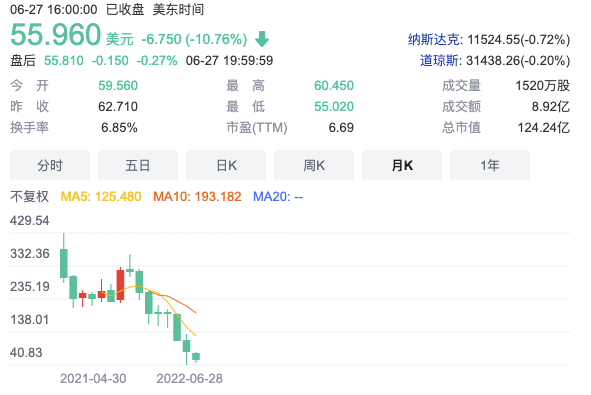Coinbase in a Bear Market: Losses, Layoffs, and Plummeting Stock Prices
Author: Kyle, Hive Tech
As of the market close on June 27, Coinbase's stock price settled at $55.96, down 10.76% during the day, while last April, it debuted as the "first stock" of a cryptocurrency exchange on Nasdaq with an opening price of $381. In just over a year, Coinbase's stock price has dropped by 85.3%.
The shift from a bull to a bear market in the cryptocurrency asset market has undoubtedly affected Coinbase's performance. According to its financial report, the company's revenue for the first quarter of this year was $1.17 billion, a year-on-year decline of 27%, resulting in a loss of $420 million, compared to a net profit of $771 million in the same period last year.
The transition from profit to loss is attributed not only to the bleak market conditions leading to a decline in trading fee income but also to increased expenditures at Coinbase. In the first quarter of this year, the company's operating expenses reached $1.72 billion, a year-on-year increase of 9%. During this period, Coinbase maintained rapid personnel expansion, hiring 1,218 new employees, bringing its total workforce close to 5,000.
As the cryptocurrency asset market further declined in June, Coinbase finally recognized the importance of "cost reduction and efficiency improvement," announcing an 18% layoff to cut costs.
In addition to the issue of excessive operating expenses, Coinbase also faces challenges from competitors like FTX and Binance. In May of this year, its spot trading volume was surpassed by FTX for the first time. Furthermore, without a derivatives trading business, Coinbase will also face cash flow pressure during the bear market.
Recently, Goldman Sachs downgraded Coinbase's stock rating from "Neutral" to "Sell," predicting a year-on-year revenue decline of about 73% in the second half of the year.
Coinbase's Stock Price Has Dropped 85.3% Since Its IPO
As the cryptocurrency asset market continues to decline, the industry's "first stock," Coinbase, has lost the luster it had when it listed on Nasdaq last year and is now viewed pessimistically by the public.
On June 27, investment bank Goldman Sachs downgraded Coinbase (COIN) from "Neutral" to "Sell," lowering its stock price target from $70 to $45. Goldman Sachs stated that the downgrade was due to the continued decline in cryptocurrency prices and the corresponding decrease in industry activity levels.
About two weeks ago, JPMorgan also downgraded Coinbase's stock rating from "Overweight" to "Neutral," reducing the target price from $171 to $68. JPMorgan pointed out in its report that since most of the company's revenue comes from cryptocurrency trading, staking, and custody, the recent market downturn could have a "significant negative impact" on Coinbase's revenue.
Coinbase went public on April 14 last year at an opening price of $381 per share, and on that day, its stock peaked at $429.5. After going public, this company, which had made substantial profits last year, began to see a continuous decline in performance and stock price.
As of the market close on June 27, Coinbase's stock price settled at $55.96, down 10.76% during the day. Its current stock price has dropped 85.3% from its initial opening price and 86.97% from its historical peak. In just over a year since its IPO, Coinbase has fallen from its peak to a trough.

Coinbase's Stock Price Continues to Decline
In the world of cryptocurrency, exchanges have always been profit centers. Even during a bear market, as long as there is trading activity in the market, trading platforms can maintain relatively stable cash flow. But why has Coinbase's stock price continued to decline with almost no rebound? What has this once benchmark company in the industry experienced?
From Coinbase's Q1 2022 financial report released in May of this year, its revenue for the first quarter was $1.17 billion, a year-on-year decline of 27%, falling short of Wall Street's expectation of $1.48 billion. In the first quarter of this year, Coinbase recorded a loss of $420 million, while in the same period last year, it had achieved a net profit of $771 million.
The shift from profit to loss stems from a general decline in Coinbase's revenue-generating businesses and a significant increase in operating expenses.
According to its financial report data, Coinbase achieved nearly $1.2 billion in net revenue in the first quarter, of which $1 billion was from trading revenue and $152 million from subscription and service revenue, a 56% decline from the fourth quarter of last year. Among these, Coinbase's retail trading revenue for cryptocurrency in the first quarter was $966 million, a year-on-year decline of 56%; institutional trading revenue was $47 million, down 48% from the fourth quarter of last year.
From the financial report data, trading fee income accounted for over 80% of Coinbase's total revenue, and the decline in its revenue is primarily due to a significant reduction in trading volume. In the first quarter of this year, Coinbase's trading volume was $309 billion, down from $547 billion in the fourth quarter of last year, a quarter-on-quarter decline of 43%. The monthly trading users (MTU) were 9.2 million, also a decrease from 11.4 million in the fourth quarter of last year.
In terms of expenses, Coinbase's total operating expenses in the first quarter were $1.72 billion, a year-on-year increase of 9%, marking the first time since the company went public that total expenses exceeded revenue. Among these, Coinbase's technology and development expenses were $571 million, a 24% increase from the fourth quarter of last year. Sales and marketing expenses were $200 million, down 18% from the fourth quarter. General and administrative expenses were $414 million, a 39% increase from the fourth quarter. Other operating expenses were $259 million, a year-on-year increase of 252%.
Although Coinbase's revenue decreased due to the downturn in the cryptocurrency market, it still generated nearly $1.2 billion in revenue. According to its financial report, the reason for Coinbase's losses may also be attributed to excessive expenditures, especially as the cryptocurrency market entered a downward cycle while Coinbase continued its rapid personnel expansion.
The financial report shows that the company added 1,218 employees in the first quarter, bringing its total workforce close to 5,000. In May of this year, Coinbase's Chief Operating Officer Emilie Choi even stated in an internal letter that the company planned to double its workforce.
Layoffs and Cost-Cutting Struggle to Cope with the Bear Market
However, as June approached, the cryptocurrency market experienced a more significant decline. As of June 28, BTC had fallen from $32,000 at the beginning of the month to $21,000, a drop of over 34% within the month.
In the context of a sluggish market environment, Coinbase's revenue was further impacted. CryptoCompare data showed that in May of this year, Coinbase's trading volume was less than $80 billion, while its average trading volume over the past 12 months was around $110 billion. Previously, Coinbase had indicated in a letter to shareholders that it expected both the number of platform users and trading volume to decline again in the second fiscal quarter.
Accompanied by the market downturn and declining revenue expectations, Coinbase finally recognized the seriousness of the situation. In late May, Coinbase halted its hiring efforts and even rejected some new employees who were supposed to join. This month, the exchange officially launched its layoff plan.
On June 14, Coinbase announced in an email that it would lay off 18% of its workforce. Based on the company's approximately 5,000 full-time employees, about 900 employees will lose their jobs. The company's founder, Brian Armstrong, stated that due to the potential economic recession, the company had grown too quickly during the bull market, and it was crucial to "reduce costs and improve efficiency" in a low-density market, thus requiring Coinbase to downsize.

Coinbase Announces 18% Layoff
Such a layoff rate is still considered low by Goldman Sachs, which believes that Coinbase may need to lay off further to maintain a relatively healthy financial condition. Goldman Sachs pointed out that as retail trading activity slows down, Coinbase will need to significantly reduce its cost base to prevent cash depletion, "however, this may negatively impact talent retention."
In the face of reduced revenue expectations, layoffs and cost-cutting are measures Coinbase has to take. But in reality, cost-cutting is only a way to alleviate cash flow issues; increasing revenue is the key to breaking through bottlenecks, and in this regard, it has been at a disadvantage compared to its competitors.
Coinbase is a compliant trading platform based in the United States, but in the cryptocurrency market, FTX and Binance also hold significant market shares. According to The Block data, in May of this year, the spot trading volume of cryptocurrency exchanges was $830.4 billion, with Binance accounting for 64.1%, while FTX surpassed Coinbase for the first time, taking second place with a share of 10.8%. In contrast, Coinbase's market share has been compressed to 9.6%. JPMorgan analysts expect that in June, FTX's spot trading volume will continue to exceed that of Coinbase.
Despite launching many new assets on its platform over the past year, Coinbase's total asset count still lags behind Binance and FTX, leading to some user attrition. A more serious issue is that due to Coinbase's strict operation within regulatory frameworks, it has yet to launch a derivatives trading business, which has resulted in its product richness falling behind competitors and its revenue-generating capability being insufficient.
Compared to spot trading, derivatives trading, such as contracts, has a much stronger revenue-generating capability. For example, Binance's derivatives trading volume far exceeds its spot trading volume; on June 26, data showed that the contract trading volume for the BTC/USDT pair on Binance was approximately eight times that of its spot trading volume.
Analysts believe that during bear market cycles, the trading volume of cryptocurrency spot markets tends to be relatively sluggish, while derivatives trading, which allows for short selling, is relatively less affected. "Without a derivatives business, relying solely on spot revenue, trading platforms will face significant cash flow pressure during bear markets."
As the Federal Reserve continues to tighten monetary easing policies, the cryptocurrency market still faces further downside risks. In the prolonged bear market, Coinbase is entering a winter. Goldman Sachs remains pessimistic about the exchange's performance in the second half of the year, "expecting its revenue to decline by about 73% year-on-year in the second half and a total revenue decline of about 61% for the year."










